| dc.description.abstract | Compared to leading edge technologies such as high speed turbomachinery, reciprocating pumps may appear to be a simple technology: A reciprocating plunger causes liquid to be drawn from a low pressure manifold through the suction check valves, and expelled into a high pressure manifold through the discharge check valves. However, the interaction of flow, valve dynamics, and the acoustics of the pump and piping system can generate high amplitude pressure pulsation, causing severe vibration and reliability problem in some systems. The effects of improperly operating valves, and the successful resolution of such problems with valve design modifications are examined. Since the pump vales are operated by the action of the fluid, valve components (including the spring, valve body, valve disc shape, and sealing surfaces, etc.) must be carefully selected to ensure that the valves open and close at the appropriate times. Problems associated with valve dynamics include over pressure spikes at the opening of discharge valves, under pressure spikes at the opening of the suction valves, high noise levels, and excessive wear of valve components. Severe over pressure spikes have been known to cause fatigue failures of pump working barrels, connecting rods, bearings, and even drive-train components. Under pressure spikes can cause cavitation that can also lead to plunger and valve failures, due to pitting damage. High level valve noise is usually indicative of sever impacts associated with the opening and closing of the valves. Impacts at the valve closing are sometimes referred to as valve hammer and can result in damage to the sealing surfaces. Impacts at the valve opening, which may be identified by damage to the back side of the valve disc, are due to the over pressure and under pressure spikes which can result in fatigue failures of the components. Excessive valve wear can also be experienced when the valve disc material is not suitable for the pumping conditions. The use of field data coupled with a computer model to analyze the valve dynamics will be presented. Using this tool, the effect of various valve modifications such as changes in sealing surfaces, valve lift, spring preload, and spring stiffness can be observed. Instrumentation and data analysis techniques to evaluate these problems will also be discussed. The effects of modifications to valves (including changes in lift, spring preload, spring construction and stiffness, valve disc geometries, etc.) will be examined using data from actual systems. | en |


